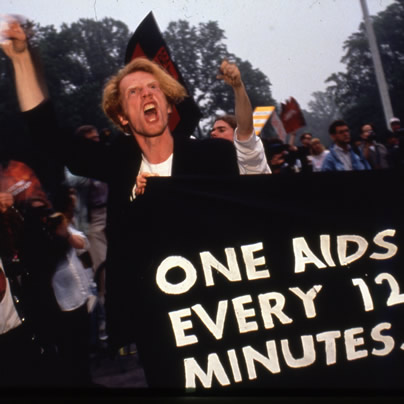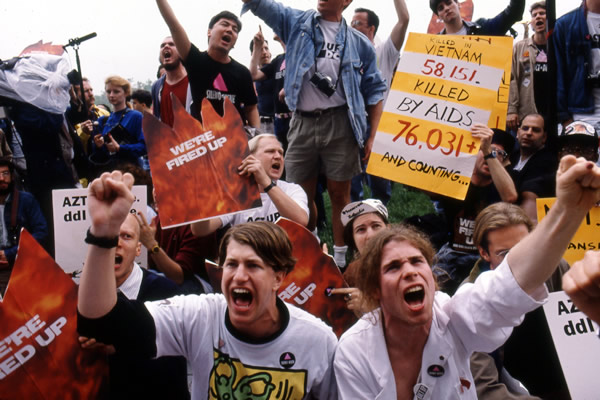Living
Surviving Oscar
Gay writer scores Academy nomination for debut film about AIDS


A scene from David France’s harrowing documentary ‘How to Survive a Plague.’ The film has its Oscar rendezvous Sunday night at the Dolby Theatre in Hollywood where its up for Best Documentary. (Photo courtesy Sundance Selects)
It sounds so straightforward — the New York Public Library had a collection of videotapes AIDS activists made decades ago with vintage camcorders back when they were heavy behemoths you had to rest on your shoulder with full-size VHS or Beta tapes inside. Filmmaker/journalist David France combed painstakingly through the clips to compose his powerful 2012 documentary “How to Survive a Plague.”
But how this was achieved — what format was the footage stored in? What condition was it in? Could anyone go in and check these out with a library card? How did France pull this off?
In some ways, it’s the least interesting part of the film’s story, which is told via a sobering chronology of video footage shot by angry protesters — the kind the Religious Right calls “militant homosexual activists.”
The film has been almost universally praised. The New York Times called it “inspiring” and crackling with “currents of rage, fear, fiery determination and finally triumph.” It has a 100 percent freshness rating among critics on Rotten Tomatoes (a film quality-ranking site), several awards including “best documentary” from the Boston Society of Film Critics. This weekend it’s up for both an Independent Spirit Award and an Oscar. Gold Derby, a site that predicts entertainment industry awards, gives it a 4/1 chance at winning the Oscar (behind “Searching for Sugar Man” which it gives 13/8 odds). “5 Broken Cameras,” “The Gatekeepers” and “The Invisible War” (made by the “Outrage” team of Kirby Dick and Amy Ziering) are also nominated.
For “Plauge,” France took footage — some of which was housed at the New York Public Library — shot by 31 videographers and paces it chronologically to the story of the formation of ACT UP (AIDS Coalition to Unleash Power), a group that formed in March 1987 in a spirit of extreme frustration during a speech activist (and “Normal Heart” playwright) Larry Kramer gave at the Lesbian and Gay Community Services Center in New York.
France, during a lengthy phone interview last weekend before he was scheduled to fly to Los Angeles on Tuesday, gladly shares the logistics behind “Plague’s” formation.
A veteran investigative journalist, author and GLAAD Media Award winner (for a GQ piece on gays in Iraq) who’s had his work published in everything from the New Yorker to Ladies’ Home Journal, France says he was a graduate student during the time AIDS hit in the early 1980s and having written about it extensively over the years, he knew activists had brought cameras to their protests. And yes, the process of crafting “Plague” was a lot more involved than simply checking tapes out of the library.
“The tapes from the library are actually just a small portion of the footage you see in the film,” France, who’s gay, says. “That’s really the first door I went through, this archive of AIDS activism video that’s housed in the Manuscript Division of the New York Library, where you go if you want to read Lincoln’s letters. It’s an exclusive corner of the library that’s not accessible to the general public and everybody’s going around wearing white gloves and handling antiquities. In one corner, they have a television and a VCR and you watch the AIDS footage recorded in those early days. It’s just raw footage, not really ever intended for public view. Some of it you’ll be watching and all of a sudden it will go to a gay porn video, which just happened to be on the same tape they recorded on.”
France says the library kept all the tapes — recorded in every home video format on the market in those years as one might imagine — but had transferred them all to the Betacam SP format, a higher resolution tape on larger cassettes that for years was the broadcast standard and is still in use today. France convinced the library to let him take select footage to a nearby production lab and have it digitized. He ended up with about 100 hours and says the process became difficult as the project moved along.
“They’re really not accustomed to working on a film production schedule, so trying to get them to hurry got more and more difficult as we went along,” he says.
And that was just the starting point — in the library footage, France saw other people holding video cameras. He started tracking them down one by one and eventually found a group of people, many long-time AIDS survivors themselves, who had videotape footage they had never revisited. Again, formats remained a challenge.
“We had all this stuff in so many different formats from private collections,” he says. “We were constantly scouring Craigslist and eBay for decks that would play these old tapes. We ended up with about 800 hours and that really became the building blocks of the film.”
And yes, France says it did take some persuasion to get these individuals to hand over their footage.
France says, “A lot of these people had moved on but I think now have started to see the real value in this footage. I think they gradually started to realize, that yes, enough time has passed and now is the time to really use it and this is the project.”
France said his project is timely and important because many of the other landmark AIDS pieces, from Kramer’s play to Randy Shilts’ “And the Band Played On” were written before the era of anti-retroviral therapy when HIV morphed into a more manageable condition.
He says the film is important for anyone interested in the AIDS fight to see.
“There were even people in ACT UP who didn’t know the outcomes of many of these things,” he says. “If you think you know the story of AIDS, this film will surprise you and that goes for just about everybody.”
http://www.youtube.com/watch?v=wwhFS1mUaVY
WASHINGTON BLADE: Will this be your first time at the Academy Awards?
DAVID FRANCE: Yes. I’ve never gotten any closer before than my television screen.
BLADE: Have you watched very often over the years?
FRANCE: Oh yeah. My boyfriend and I always have an Oscar party. With ballots and everything. I’ve never won.
BLADE: What’s your favorite Oscar memory?
FRANCE: Tom Hanks’ acceptance speech when he won for “Philadelphia.” That’s really seared in my memory.
BLADE: What did you think of Michael Moore’s controversial speech when he won the category you’re up for? Ballsy or inappropriate for the occasion?
FRANCE: I think if you’ve got an audience of a billion people and you’ve got something to say, you need to say it. That’s not to say I’m intending any surprises should I have that opportunity.
BLADE: Have you seen the competition?
FRANCE: Of course. They’re all brilliant films.
BLADE: If you win, where will you put Oscar?
FRANCE? I’m not sure. I keep the other awards we’ve won in the production office so everyone on the crew can enjoy them and hopefully see their own contribution but if we get this little gold thing, I’m not sure. I have no idea.
BLADE: Do you feel AIDS, as horrible as it was and is, put gay issues on the national radar and that ended up being a silver lining to the cloud or is that an absurd oversimplification?
FRANCE? No, it’s absolutely true. Before that, gay people were entirely disenfranchised and we were not seen as being contributing members to the culture at all. We had no role whatsoever in civic life … From those ashes (of AIDS), now we have a president who acknowledges us as human beings and Stonewall is mentioned in the same breath as Seneca Falls.
BLADE: How did you feel when Dustin Lance Black won for “Milk”?
FRANCE: I felt it was incredible. He gave a great speech and I thought it was a very, very good movie.
BLADE: Did you plan all along to submit it for a nomination? What’s the process like?
FRANCE: There are all kinds of rules about it playing in New York and L.A. and being reviewed by the New York Times and the Los Angeles Times and that’s just the first threshold. I was lucky I had a distributor who saw the potential for the film early on and made sure we did everything we needed to do for both the Oscars and the Independent Spirit Awards. … Anytime you make a film, sure, you fantasize about getting an Oscar nomination and it’s really just because you want more people to see it. An Oscar bump is a tremendous thing.
Real Estate
Navigating DMV real estate market during political unrest
Reductions in federal employment have introduced uncertainties

The Washington, D.C.-Maryland-Virginia (DMV) region has long been recognized for its robust housing market, underpinned by the presence of the federal government and a diverse economic landscape. Recent massive reductions in federal employment have introduced uncertainties, yet the area continues to offer compelling reasons for prospective homebuyers, particularly within diverse communities.
While the federal government has traditionally been a significant employer in the DMV, the region has proactively diversified its economic base. Sectors such as technology, professional services, education, and healthcare have expanded, mitigating the impact of federal job cuts. This diversification fosters some economic resilience, which offers our area a semblance of protection against the impending unknowns that we currently face. Nothing can shield real estate entirely; however, our area tends to survive these types of changes better than other parts of the country.
Despite concerns over federal layoffs, the DMV housing market has demonstrated notable stability. Analyses indicate that the number of active listings, sold properties, and median sales prices have remained steady on a year-over-year basis. This steadiness suggests that the market is adapting to changes without significant disruption.
Furthermore, while there has been a slight increase in home listings, this trend aligns with typical seasonal variations and does not solely reflect federal employment changes. The luxury property segment, in particular, continues to thrive, indicating sustained interest and investment in the region.
The DMV region is renowned for its cultural and demographic diversity, with areas like Montgomery County, Md., being among the most ethnically diverse in the nation. This inclusivity extends to various communities, including LGBTQ individuals, fostering a welcoming environment that enhances the area’s appeal. Even though the current administration is fostering anti-diversity ideology, I remain confident that our LGBTQ community will continue to thrive even as these destructive forces work against us.
Local governments within the DMV have implemented policies aimed at promoting affordable housing and preventing displacement, particularly in the wake of economic shifts. Initiatives like the Douglass Community Land Trust in Washington, D.C., exemplify efforts to maintain housing affordability and support community stability.
Additionally, jurisdictions such as Montgomery County have longstanding Moderately Priced Dwelling Unit (MPDU) programs that require developers to include affordable housing in new residential developments. These policies contribute to socioeconomically mixed neighborhoods, benefiting diverse populations.
Despite Elon Musk’s brandishing of a chainsaw to the federal workforce, our real estate market continues to thrive. The DMV region maintains its appeal. Economic diversification, market stability, commitment to diversity and inclusion, and progressive housing policies collectively contribute to an environment that supports and attracts diverse communities. Prospective homebuyers can find reassurance in the region’s resilience and ongoing efforts to foster an inclusive and vibrant community. These are only a few among the many reasons to have a positive outlook while considering real estate options in our area.
It is important to consider working with brokerages, brokers, agents, lenders and title companies who align with our community and our objectives. Not all LGBTQ agents work for brokerages that support or understand the needs of the members of our community. Do your research and find out who has donated money to what political causes. Now more than ever we must support members of our community to protect our way of life and our very existence.
Stacey Williams-Zeiger is president/principal broker of Zeiger Realty Inc. Reach her at [email protected].

Hi Michael,
When I came to D.C. for college and came out, I was idealistic about finding true love. I made gay friends at school and watched them hooking up all the time.
It seemed like the opposite of what I wanted. I dreamed of meeting “Prince Charming” and living happily ever after. I thought I would put off sex until I met my special guy.
This went on for a while until I got too horny and impatient to keep putting off sex. The boyfriend wasn’t materializing so I went online and hooked up. Actually it was a lot of fun.
Soon I was hooking up as much as any of my friends were. I kept hoping I’d still find my prince. But over time most of my energy shifted to finding guys to have sex with.
Now I’m 34. I’ve been at this a long time and I realized the other day that I don’t like my life.
I haven’t been on a real date in years but I’m hooking up multiple times a week. I’ve been with almost everyone I see on the apps whom I find attractive (where the feeling was mutual). And yes, I’ve been with a lot whom I didn’t find attractive because I was horny.
I look at myself and I think, yuk. I don’t like whom I’ve become.
I feel like I am addicted to hooking up. I just keep craving something. The release but mostly the attention, that the other person finds me hot. After I come, I feel like the whole thing was pointless, and a little disgusted with myself. Advice?
Michael replies:
You’re using hookups not just for sex, but as a way to feel good about yourself by getting positive attention from others.
But other-validation is like junk food, a sugary snack that staves off hunger for a few minutes and never really fills you up. All those guys you hook up with? The attention feels great, but as you wrote, that feeling lasts until your orgasm. And then you’re back to chasing it.
As with junk food, the other-validation you get when you hook up is a lot of empty calories. Having someone you don’t even know agree to have sex with you says nothing meaningful about your worth or even your attractiveness.
Yet another problem: If you believe that you need other-validation, you will do all sorts of self-damaging behaviors to get it—such as hookups that leave you feeling empty and disgusted. I’ve seen many people lose their self-respect in the service of getting other people’s positive attention through behaviors that violate their own integrity. Doing things that make you feel bad about yourself in an attempt to feel good about yourself is ironic, and sad.
The bottom line is that other people can’t “make” you feel good about yourself. They might give you a small temporary boost, but your self-esteem actually has to come from you. That’s why it’s called self-esteem. Once you are past a certain age, if you don’t believe that you have value, no one else can get you there. You have to validate yourself.
Let’s go big-picture for a moment: It is our parents’ job to teach us that we have value when we are little, and when that doesn’t happen, we often struggle with self-esteem throughout our lives, unless we can find a path to develop our own belief in our worth. In the meantime, we may chase other-validation in a futile attempt to fill ourselves up.
Other experiences we go through—for example, growing up gay in a hostile environment—can also do a number on how we see ourselves, and leave us grasping for affirmation from others. It takes work to get through and get past the impact of these experiences.
So how do you get better at giving yourself the validation you are seeking? There’s a great saying from the 12-step programs: If you want to have self-esteem, behave in esteemable ways.
What would it mean for you to behave in a way that you respect? Your letter provides one answer that is true for you: Stop engaging in sexual encounters that leave you disliking yourself.
Far easier said than done, right? But that doesn’t mean it’s impossible. Having gotten clarity that you don’t like the life you’ve constructed for yourself, now you actually can do something about it. Keep in mind, though, that you will face some challenges if you stop hooking up.
First: You may find it isolating and scary to stop doing something that all or most of your friends are doing. You will have to reassure yourself that you’re doing what’s right for you; that you are taking good care of yourself by choosing to avoid behaviors that leave you feeling bad; and that it’s OK to be different from “everyone else.” In other words, you are going to have to get much better at self-validation.
If you have some friends who don’t spend a lot of their time hooking up, they may be good supports for you. Some guys find camaraderie from attending a 12-step program like Sexual Compulsives Anonymous (SCA).
Second: People often use hookups (and sex) not just for sexual gratification, but to soothe anxiety, stress, depression, and other uncomfortable feelings. If you stop hooking up, you will likely need some other ways to keep yourself calm and to steady your mood. Exercise and meditation are two obvious means.
You’d be wise to figure out new ways to fill your time that give you a sense of meaning and connection. I can’t tell you what those might be; only you can figure out what is right for you. They might include developing or deepening warm friendships, taking good care of yourself, finding a new activity that interests you — the list can go on and on.
If you still want to find your prince, this is the way to go about it. The cliché is true: You can’t expect anyone to like you unless you like yourself. If you build a life rich in fulfilling pursuits that help you to feel good about who you are and the life you are leading, you will be transforming yourself into relationship material.
Keep in mind, though, that letting yourself get close to someone through a heart connection would mean having to confront all sorts of uncomfortable emotions, including feeling vulnerable, that you have avoided by limiting yourself to crotch attachments.
That said, working to become a more solid person would help you develop the strength to tolerate the ongoing challenges of a close relationship.
Michael Radkowsky, Psy.D. is a licensed psychologist who works with couples and individuals in D.C. He can be found online at michaelradkowsky.com. All identifying information has been changed for reasons of confidentiality. Have a question? Send it to [email protected].

Whether you are upgrading parts of your current home to prepare it for sale or enhancing the home you just purchased, kitchens and bathrooms are still at the top of the renovation list.
Kitchen renovations have always embraced a blend of functionality, personalization, and aesthetic appeal; however, homeowners are currently moving away from sterile, uniform designs, opting instead for spaces that reflect warmth, character, and individual style. Here are some of the most prominent trends shaping kitchen renovations this year.
Warm and Earthy Tones
The dominance of all-white kitchens is waning as homeowners gravitate toward warmer, earth-toned palettes. Shades like sage green, navy blue, and natural wood finishes are becoming popular choices for cabinetry, infusing kitchens with a cozy and inviting atmosphere. This shift reflects a desire for spaces that feel more personalized and less clinical. Flat panel and Shaker cabinets continue to be popular options.
Integration of Organic Modernism
The “modern organic” style is gaining traction, characterized by using natural materials, neutral color palettes, and serene layouts. Incorporating elements like soapstone countertops, Venetian plaster walls, slate floors, and greenery not only enhances aesthetic appeal but can also increase home values significantly. Fully outfitted outdoor kitchens further contribute to this trend.
Innovative Kitchen Island Designs
Kitchen islands continue to be central features, with designs evolving to incorporate textures, wood and tile cladding, multifunctional elements, and bold colors and materials. Integrated seating areas, waterfall countertops, and the use of monolithic stone or stacked marble are becoming increasingly popular. These islands not only serve as functional workspaces but also as striking focal points within the kitchen.
Concealed Kitchens for a Sleek Look
The concept of concealed kitchens is on the rise, emphasizing built-in appliances, flush cabinetry, and appliance garages to maintain a clutter-free environment. This design approach fosters a minimalist aesthetic, creating a seamless flow between the kitchen and adjacent living areas, particularly in open-concept homes.
Personalized Cabinetry and Storage Solutions
Customization is key in modern kitchen designs, with homeowners seeking tailored storage solutions that cater to their specific needs. Features like hidden storage compartments, integrated lighting, and unique hardware choices are being favored over generic, cookie-cutter options. This trend underscores a move toward kitchens that are both functional and reflective of personal style.
Revival of Traditional Styles with Modern Twists
Traditional kitchen styles are making a comeback, with a contemporary twist. Elements such as expanded backsplash coverage, classic tile shapes and patterns, use of mixed metals, and specialty appliances are being integrated into modern kitchens, blending the charm of the past with the conveniences of the present. Custom range hoods, coffee bars and microwave drawers are increasingly added to renovation projects. This fusion creates spaces that are both timeless and equipped for modern living.
Sustainable and Natural Materials
Sustainability remains a priority, with an increased use of eco-friendly materials like reclaimed wood, recycled metals and glass, and energy-efficient appliances. This not only reduces environmental impact but also introduces unique texture and shimmer into kitchen designs, adding depth and character to the space.
Use of Bold Colors and Accents
Homeowners are becoming more adventurous with color and texture, incorporating vibrant hues and tactile materials into their kitchen designs. Features like colorful window trims, two-tone cabinets, and the use of wallpaper and feature walls add visual interest and a personalized touch to the space. In addition to the familiar white, major appliances are now shown in matte black, navy, and jewel tones of red, green, and blue. There are even vinyl wraps and magnet covers that allow for more creativity and individualization with appliances.
Integration of Smart Technology
The incorporation of smart technology continues to grow, with appliances featuring automated cooking functions, sensor reheating, and control locks becoming more prevalent. Induction stoves are entering the mix. Charging stations and touch-activated cabinet doors and faucets are also popular. LED lighting lasts longer and prevents you from having to climb a ladder to change lightbulbs on a high or vaulted ceiling. These advancements enhance convenience and efficiency, aligning with the modern homeowner’s desire for a kitchen that supports a tech-savvy and busy lifestyle.
Multifunctional Spaces
Kitchens are increasingly being designed as multifunctional spaces that accommodate cooking, dining, working, and socializing. This has led to the inclusion of features like integrated seating, versatile lighting, and adaptable layouts that can easily transition between different uses, reflecting the evolving role of the kitchen in contemporary homes. Still, don’t be surprised to see a resurgence of self-contained kitchens with real walls.
So, whether the kitchen you want is sleek and modern, earthy and organic, or traditional and elegant, there will always be fresh new styles, ideas, innovations and classic touches that cater to your lifestyle.
Valerie M. Blake is a licensed Associate Broker in D.C., Maryland, and Virginia with RLAH @properties. Call or text her at 202-246-8602, email her via DCHomeQuest.com, or follow her on Facebook at TheRealst8ofAffairs.
-

 El Salvador4 days ago
El Salvador4 days agoGay Venezuelan makeup artist remains in El Salvador mega prison
-

 State Department3 days ago
State Department3 days agoHIV/AIDS activists protest at State Department, demand full PEPFAR funding restoration
-

 Opinions5 days ago
Opinions5 days agoScience must not be a weapon against trans people
-

 Maryland5 days ago
Maryland5 days agoMd. schools plan to comply with federal DEI demands









